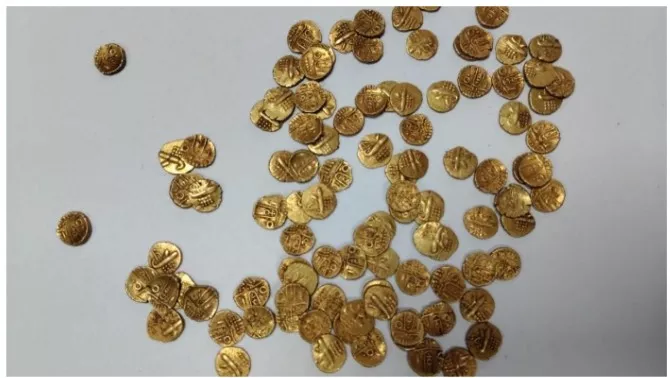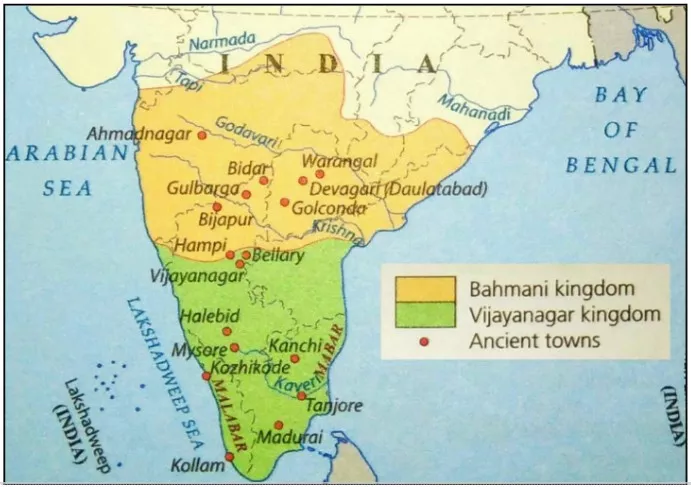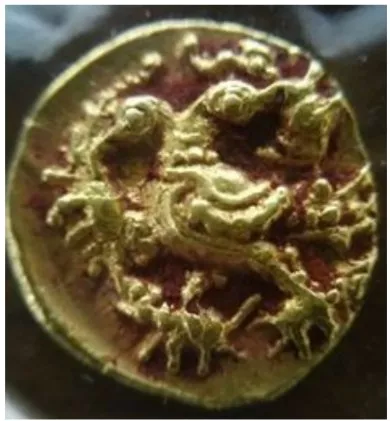Over 100 gold coins dating back to the Vijayanagara era have been discovered during restoration work at a Later Chola-era Shiva temple in Kovilur hamlet atop the in Tiruvannamalai district, Tamil Nadu.
Details of the Discovery
- Characteristics of Coin:
- Average size: ~5 millimetres in diameter.
- Circular in shape (unlike the square-shaped coins of the Sangam Age).
- Symbol: Some coins bear the emblem of a pig, a royal symbol of the Vijayanagara Empire, representing Varaha, the boar incarnation of Lord Vishnu
 Estimated Age: The coins likely belong to the Vijayanagara period (14th–16th century CE), when Krishnadevaraya and his successors revived temple architecture and endowed temples with gold and valuables.
Estimated Age: The coins likely belong to the Vijayanagara period (14th–16th century CE), when Krishnadevaraya and his successors revived temple architecture and endowed temples with gold and valuables.- Purpose of Deposition: According to archaeologists, coins were deposited under temple sanctums for two main reasons:
- Religious Offering: Gold coins were buried beneath sanctums as offerings to deities to invoke prosperity and divine protection for the region.
- Economic Usage: Metal coins (especially copper and silver) were also used for economic transactions due to durability and resistance to melting.
About Vijayanagara Empire

- Foundation and Origin:
- The Vijayanagara Empire was founded in 1336 CE on the banks of the Tungabhadra River (modern Hampi, Karnataka) by Harihara I and Bukka Raya I, under the guidance of Saint Vidyaranya.
- The empire’s capital, Vijayanagara (“City of Victory”), became one of the most prosperous and well-fortified cities of medieval India.
- Dynasties:
-
- Sangama Dynasty (1336–1485 CE) – Founders Harihara & Bukka.
- Saluva Dynasty (1485–1505 CE) – Transition period.
- Tuluva Dynasty (1505–1570 CE) – Peak under Krishnadevaraya.
- Aravidu Dynasty (1570–1646 CE) – Last phase until decline.
Key Features of Coins of the Vijayanagara Empire
- Metal Composition
- The Vijayanagara Empire issued coins in gold, silver, and copper, showcasing its economic strength and vast trade network.
- The gold Pagoda (Varaha) was the highest denomination, while gold fanams, silver taras, and copper kasu were used for everyday transactions.
- Regional Coinage: Early coins were region-specific, such as Barkur Gadyanas and Bhatkal Gadyanas.
- Harihara I and Bukka introduced gold fanams and silver taras, setting the standard for later issues.
- Religious and Cultural Symbols:
- The coins prominently featured Hindu deities and sacred motifs, reflecting the empire’s religious devotion and cultural ethos.
- Harihara II introduced depictions of Brahma, Vishnu, and Shiva on gold Pagodas.
- Krishnadevaraya’s coins displayed the famous Balakrishna (infant Krishna) motif.
- Achyuta Raya used the Ganda Berunda (double-headed eagle) — symbolizing royal power.
- Tirumala Raya (Aravidu dynasty) depicted Rama, Lakshmana, and Sita, highlighting Vaishnava influence.
- Legends and Language:
 Inscriptions on the coins bore the names and titles of rulers.
Inscriptions on the coins bore the names and titles of rulers.- Languages/Scripts: Kannada, Telugu, Tamil, and Nagari, reflecting the linguistic diversity of the empire.
- Example: Coins inscribed with “Sri Krishnadevaraya” in Nagari and Kannada scripts.
- Symbolism:
- The Boar (Varaha) — an incarnation of Vishnu — served as the dynastic emblem.
- Use of deities, animals (elephant, horse), and mythological symbols reinforced the idea of Dharma and divine kingship.
- The Ganda Berunda (double-headed eagle) symbolized strength, protection, and imperial sovereignty.
- Economic Role:
- Gold Pagodas and silver Taras circulated across South India and Indian Ocean trade routes, especially with Southeast Asia.
- The standardized denominations and weights ensured commercial reliability.
- Copper coins served local markets and facilitated daily transactions.
- Coins also reflect the monetary uniformity and administrative efficiency of the Vijayanagara state.
![]() 6 Nov 2025
6 Nov 2025

 Estimated Age: The coins likely belong to the Vijayanagara period (14th–16th century CE), when Krishnadevaraya and his successors revived temple architecture and endowed temples with gold and valuables.
Estimated Age: The coins likely belong to the Vijayanagara period (14th–16th century CE), when Krishnadevaraya and his successors revived temple architecture and endowed temples with gold and valuables.

 Inscriptions on the coins bore the names and titles of rulers.
Inscriptions on the coins bore the names and titles of rulers.